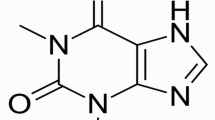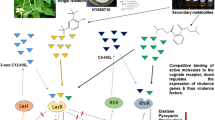Abstract
Inhibition of quorum sensing (QS)-regulated virulence factors including biofilm is a recognized anti-pathogenic drug target. The search for safe and effective anti-QS agents is expected to be useful to combat diseases caused by multidrug-resistant bacteria. In this study, effect of a commonly used antibiotic, doxycycline on QS was evaluated using sensor strains of Chromobacterium violaceum (ATCC 12472 and CVO26) and Pseudomonas aeruginosa PAO1. Sub-MICs of doxycycline reduced QS-controlled violacein production in C. violaceum to a significant degree (70 %) and showed a significant reduction of LasB elastase (67.2 %), pyocyanin (69.1 %), chitinase (69.8 %) and protease (65 %) production and swarming motility (74 %) in P. aeruginosa PAO1 over untreated controls. Similar results were also recorded against a clinical strain of P. aeruginosa (PAF-79). Interestingly, doxycycline at respective sub-MICs (4 and 32 μg ml−1) significantly reduced the biofilm-forming capability and exopolysaccharide production in both the strains of P. aeruginosa (PAO1 and PAF-79) over untreated controls. The results of this study highlight the multiple actions of doxycycline against QS-linked traits/virulence factors and its potential to attenuate virulence of P. aeruginosa.




Similar content being viewed by others
References
Abraham SVPI, Palani A, Ramaswamy BR, Shunmugiah KP, Arumugam VR (2011) Antiquorum sensing and antibiofilm potential of Capparis spinosa. Arch Med Res 42:658–668
Antunes LC, Ferreira RB, Buckner MM, Finlay BB (2010) Quorum sensing in bacterial virulence. Microbiol 156:2271–2282
Babić F, Venturi V, Maravić-Vlahoviček G (2010) Tobramycin at sub-inhibitory concentration inhibits the RhlI/R quorum sensing system in a Pseudomonas aeruginosa environmental isolate. BMC Infect Dis 10:148–160
Bjarnsholt T, Givskov M (2008) Quorum sensing inhibitors as next generation antimicrobials: worth the effort? Curr Infect Dis Report 10:22–28
Bjarnsholt T, Jensen PO, Rasmussen TB, Chritopherson L, Calum H, Hentzer M, Hougen HP, Rygaard J, Moser C, Eberl L, Hoiby N, Givskov M (2005) Garlic blocks quorum sensing and promotes rapid clearing of pulmonary Pseudomonas aeruginosa infections. Microbiol 151:3873–3880
Blosser RS, Gray KM (2000) Extraction of violacein from Chromobacterium violaceum provides a new quantitative bioassay for N-acyl homoserine lactone autoinducers. J Microbiol Methods 40:47–55
Brint JM, Ohman DE (1995) Synthesis of multiple exoproducts in Pseudomonas aeruginosa is under the control of RhlR-RhlI, another set of regulators in strain PAO1 with homology to the autoinducer-responsive LuxR-LuxI family. J Bacteriol 177:7155–7163
Camara M, Williams P, Hardman A (2002) Controlling infection by tuning in and turning down volume of bacterial small-talk. Lancet Infect Dis 2:667–676
Caraher E, Reynolds G, Murphy P, McClean S, Callaghan M (2007) Comparison of antibiotic susceptibility of Burkholderia cepacia complex organisms when grown planktonically or as biofilm in vitro. Eur J Clin Microbiol 26:213–221
Clinical and Laboratory Standards Institute (2007) Performance standards for antimicrobial susceptibility testing: Seventeenth Informational Supplement: M100–S17. CLSI, Wayne
Davies DG, Parsek MR, Pearson JP, Iglewski BH, Costerton JW, Greenberg EP (1998) The involvement of cell-to-cell signals in the development of a bacterial biofilm. Science 280:295–298
Driscoll JA, Brody SL, Kollef MH (2007) The epidemiology, pathogenesis, and treatment of Pseudomonas aeruginosa infections. Drugs 67:351–368
Dubois MK, Gils JK, Hanniton PA, Robes SF (1956) Use of phenol reagent for the determination of total sugar. Anal Chem 28:350
Essar DW, Eberly L, Hadero A, Crawford IP (1990) Identification and characterization of genes for a second anthranilate synthase in Pseudomonas aeruginosa: interchangeability of the two anthranilate synthases and evolutionary implications. J Bacteriol 172:884–900
Fatima Q, Zahin M, Khan MSA, Ahmad I (2010) Modulation of quorum sensing controlled behaviour of bacteria by growing seedling, seed and seedling extracts of leguminous plants. Indian J Microbiol 50:238–242
Folders J, Algra J, Roelofs MS, van Loon LC, Tommassen J, Bitter W (2001) Characterization of Pseudomonas aeruginosa chitinase, a gradually secreted protein. J Bacteriol 183:7044–7052
Fuqua C, Greenberg EP (2002) Listening in on bacteria: acylhomoserine lactone signaling. Nat Rev Mol Cell Biol 3:685–695
Garske LA, Beatson SA, Leech AJ, Walsh SL, Bell SC (2004) Sub-inhibitory concentrations of ceftazidime and tobramycin reduce the quorum sensing signals of Pseudomonas aeruginosa. Pathol 36:571–575
Givskov M, de Nys R, Manefield M, Gram L, Maximilien R, Eberl L, Molin S, Steinberg PD, Kjelleberg S (1996) Eukaryotic interference with homoserine lactone-mediated prokaryotic signalling. J Bacteriol 178:6618–6622
Glessner A, Smith RS, Iglewski BH, Robinson JB (1999) Roles of the Pseudomonas aeruginosa las and rhl quorum-sensing systems in control of twitching motility. J Bacteriol 181:1623–1629
Harshey RM (2003) Bacterial motility on a surface: many ways to a common goal. Annu Rev Microbiol 57:249–273
Hentzer M, Reidel K, Rasmussen TB, Heydorn A, Andersen JB, Parsek MR, Rice SA, Eberl L, Molin S, Hoiby N, Kjelleberg S, Givskov M (2002) Inhibition of quorum sensing in Pseudomonas aeruginosa biofilm bacteria by a halogenated furanone compound. Microbiol 148:87–102
Hentzer M, Wu H, Andersen JB, Riedel K, Rasmussen TB, Bagge N, Kumar N, Schembri MA, Song Z, Kristoffersen P, Manefield M, Costerton JW, Molin S, Eberl L, Steinberg P, Kjelleberg S, Hoiby N, Givskov M (2003) Attenuation of Pseudomonas aeruginosa virulence by quorum sensing inhibitors. EMBO J 22:3803–3815
Huston AL, Methe B, Deming JW (2004) Purification, characterization and sequencing of an extracellular cold-active aminopeptidase produced by marine psychrophile Colwellia psychrerythraea strain 34H. Appl Environ Microbiol 70:3321–3328
Jimenez PN, Koch G, Thompson JA, Xavier KB, Cool RH, Quax WJ (2012) Multiple signaling systems regulating virulence in Pseudomonas aeruginosa. Microbiol Mol Biol Rev 76:46–65
Keshavan ND, Chowdhary PK, Haines DC, Gonzalez JE (2005) L-Canavanine made by Medicago sativa interferes with quorum sensing in Sinorhizobium meliloti. J Bacteriol 187:8427–8436
Khan MSA, Zahin M, Hasan S, Husain FM, Ahmad I (2009) Inhibition of quorum sensing -regulated bacterial functions by plant essential oils with special reference to clove oil. Lett Appl Microbiol 49:354–360
Kharazmi A (1989) Interactions of Pseudomonas aeruginosa proteases with the cells of the immune system. Antibiot Chemother 42:42–49
Latifi A, Winson MK, Foglino M, Bycroft BW, Stewart GSAB, Lazdunski A, Williams P (1995) Multiple homologues of LuxR and LuxI control expression of virulence determinants and secondary metabolites through quorum sensing in Pseudomonas aeruginosa PAO1. Mol Microbiol 17:333–343
LeVatte MA, Woods DE, Shahrabadi MS, Semjrfe R, Sokol PA (1990) Subinhibitory concentrations of tetracycline inhibit surface expression of the Pseudomonas aeruginosa ferripyochelin binding protein in vivo. J Bacteriol 26:215–225
Martinelli D, Grossmann G, Sequin U, Brandl H, Bachofen R (2004) Effects of natural and chemically synthesized furanones on quorum sensing in Chromobacterium violaceum. BMC Microbiol 4:25
McClean KH, Winson MK, Fish L, Taylor A, Chhabra SR, Camara M, Daykin M, Lamb JH, Swift S, Bycroft BW, Stewart GS, Williams P (1997) Quorum sensing in Chromobacterium violaceum: exploitation of violacein production and inhibition for the detection of N-acylhomoserine lactones. Microbiology 143:3703–3711
McLean RJC, Pierson LS III, Fuqua C (2004) A simple screening protocol for the identification of quorum signal antagonists. J Microbiol Methods 58:351–360
Mesaros N, Nordmann P, Plesiat P, Roussel-Delvallez M, Van Eldere J, Glupczynski Y, Van Laethem Y, Jacobs F, Lebecque P, Malfroot A, Tulkens PM, Van Bambeke F (2007) Pseudomonas aeruginosa: resistance and therapeutic options at the turn of the new millennium. Clin Microbiol Infect 13:560–578
Musthafa KS, Balamurugan K, Pandian SK, Ravi AV (2012) 2, 5-Piperazinedione inhibits quorum sensing-dependent factor production in Pseudomonas aeruginosa PAO1. J Basic Microbiol 52:1–8
Nalca Y, Jansch L, Bredenbruch F, Geffers R, Buer J, Haussler S (2006) Quorum-sensing antagonistic activities of azithromycin in Pseudomonas aeruginosa PAO1: a global approach. Antimicrob Agents Chemother 50:1680–1688
O’Toole GA, Kolter R (1998) Initiation of biofilm formation in Pseudomonas fluorescens WCS365 proceeds via multiple, convergent signaling pathways: a genetic analysis. Mol Microbiol 28:449–461
Ochsner UA, Reiser J (1995) Autoinducer-mediated regulation of rhamnolipid biosurfactant synthesis in Pseudomonas aeruginosa. Proc Natl Acad Sci USA 92:6424–6428
Ohman DE, Cryz SJ, Iglewski BH (1980) Isolation and characterization of a Pseudomonas aeruginosa PAO mutant that produces altered elastase. J Bacteriol 142:836–842
Rasko DA, Sperandio V (2010) Anti-virulence strategies to combat bacteria-mediated disease. Nat Drug Rev 9:117–128
Riera E, Macia MD, Mena A, Mulet X, Pe′rez JL, Ge Y, Oliver A (2010) Anti-biofilm and resistance suppression activities of CXA-101 against chronic respiratory infection phenotypes of Pseudomonas aeruginosa strain PAO1. J Antimicrob Chemother 65:1399–1404
Schaber JA, Hammond A, Carty NL, Williams SC, Colmer-Hamood JA, Burrowes BH, Dhevan V, Griswold JA, Hamood AN (2007) Diversity of biofilms produced by quorum-sensing deficient clinical isolates of Pseudomonas aeruginosa. J Med Microbiol 56:738–748
Skindersoe ME, Alhede M, Phipps R, Yang L, Jensen PO, Rasmussen TB, Bjarnsholt T, Tolke-Nielsen T, Høiby N, Givskov M (2008) Effects of antibiotics on quorum sensing in Pseudomonas aeruginosa. Antimicrob Agents Chemother 52:3648–3663
Swift S, Downie JA, Whitehead NA, Barnard AML, Almond GPC, Williams P (2001) Quorum sensing as a population density-dependent determinant of bacterial physiology. Adv Microb Physiol 45:199–270
Tateda K, Comte R, Pechere JC, Kohler T, Yamaguchi K, Van Delden C (2001) Azithromycin inhibits quorum sensing in Pseudomonas aeruginosa. Antimicrob Agents Chemother 45:1930–1933
Teplitski M, Robinson JB, Bauer WD (2000) Plants secrete substances that mimic bacterial N-acyl homoserine lactone signal activities and affect population density dependent behaviors in associated bacteria. Mol Plant Microbe 13:637–648
Tre-Hardy M, Vanderbist F, Traore H, Devleeschouwe MJ (2008) In vitro activity of antibiotic combinations against Pseudomonas aeruginosa biofilm and planktonic cultures. Int J Antimicrob Ag 31:329–336
Van Delden C, Pesci EC, Pearson JP, Iglewski BH (1998) Starvation selection restores elastase and rhamnolipid production in a Pseudomonas aeruginosa quorum-sensing mutant. Infect Immun 66:4499–4502
Vattem DA, Mihali KK, Crixell SH, Mclean RJC (2007) Dietary phytochemicals as quorum sensing inhibitors. Fitoterapia 78:302–310
Vu B, Miao C, Russell JC, Ivanova EP (2009) Bacterial extracellular polysaccharides involved in biofilm formation. Molecules 14:2535–2554
Watnick PI, Kolter R (1999) Steps in the development of a Vibrio cholerae El Tor biofilm. Mol Microbiol 34:586–595
Williams P (2007) Quorum sensing, communication and cross kingdom signaling in the bacterial world. Microbiology 153:3923–3928
Winzer K, Williams P (2001) Quorum sensing and the regulation of virulence gene expression in pathogenic bacteria. Int J Med Microbiol 291:131–143
Wu H, Song Z, Hentzer M, Andersen JB, Molin S, Givskov M, Hoiby N (2004) Synthetic furanones inhibit quorum-sensing and enhance bacterial clearance in Pseudomonas aeruginosa lung infection in mice. J Antimicrob Chemother 53:1054–1061
Yildiz FH, Schoolnik GK (1999) Vibrio cholerae O1 El Tor: identification of a gene cluster required for the rugose colony type, exopolysaccharide production, chlorine resistance, and biofilm formation. PNAS 96:4028–4033
Zahin M, Hasan S, Aqil F, Khan MSA, Husain FM, Ahmad I (2010) Screening of Indian medicinal plants for their anti-quorum sensing activity. Indian J Exp Biol 48:1219–1224
Zhao T, Liu Y (2010) N-acetylcysteine inhibit biofilms produced by Pseudomonas aeruginosa. BMC Microbiol 10:140–148
Zhu H, Sun SJ (2008) Inhibition of bacterial quorum sensing-regulated behaviors by Tremella fuciformis extract. Curr Microbiol 57:418–422
Acknowledgments
The authors gratefully acknowledge the financial assistance provided by the University Grants Commission (Grant No. F. 33-208/2007) and Department of Science and Technology (DST), New Delhi, India for awarding an INSPIRE fellowship to Fohad M Husain. We are also thankful to Professor Robert JC McLean, Texas State University, USA, for providing QS bioreporter strains.
Author information
Authors and Affiliations
Corresponding author
Rights and permissions
About this article
Cite this article
Husain, F.M., Ahmad, I. Doxycycline interferes with quorum sensing-mediated virulence factors and biofilm formation in Gram-negative bacteria. World J Microbiol Biotechnol 29, 949–957 (2013). https://doi.org/10.1007/s11274-013-1252-1
Received:
Accepted:
Published:
Issue Date:
DOI: https://doi.org/10.1007/s11274-013-1252-1




